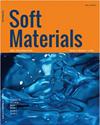椰油酰胺丙基甜菜碱(CAPB) -磺化聚苯乙烯(PSS)通过静电和疏水相互作用形成配合物
IF 1.4
4区 材料科学
Q4 MATERIALS SCIENCE, MULTIDISCIPLINARY
引用次数: 0
摘要
摘要以聚苯乙烯废料为原料制备聚电解质磺化聚苯乙烯(PSS)。用FTIR光谱对合成的PSS进行了表征,得到了三氧化硫基团的谱带。热重分析(TGA)证实了该材料与起始材料相比具有较高的稳定性。在25℃条件下,利用电导率和粘度测定技术,研究了三种不同pH值水溶液中带相反电荷的聚电解质(PSS)与表面活性剂椰油酰胺丙基甜菜碱(CAPB)的相互作用。表面活性剂的CMC高于临界聚集浓度(CAC),远低于饱和浓度(C2)。PSS与两性离子表面活性剂CAPB有很强的相互作用。在pH为2.5时,聚合物为强阴离子,与阳离子表面活性剂的结合以静电电荷中和为主。在pH为5.2和9时,CAPB与PSS之间的静电吸引力减弱,疏水相互作用增强。盐浓度对CAPB与PSS相互作用的影响取决于增加相互作用与过滤相互作用之间的竞争。注入盐和酸后,离子强度对这些相互作用至关重要。CAC和C2受到电解质和介质电荷的影响,这是由于与没有碱-表面活性剂的聚合物体系相比,碱对表面活性剂的协同作用,也可能是由于在盐的存在下聚电解质和表面活性剂之间形成的键增加。关键词:磺化聚苯乙烯、酰胺丙基甜菜碱、临界胶束浓度、疏水相互作用、疏水聚集体披露声明作者未报告潜在利益冲突。作者贡献所有作者对论文的贡献相同。本文的补充数据可以在线访问https://doi.org/10.1080/1539445X.2023.2277726。本文章由计算机程序翻译,如有差异,请以英文原文为准。
The complex formed between Cocamidopropyl betaine (CAPB) – sulfonated polystyrene (PSS) via electrostatic and hydrophobic interactions
ABSTRACTThis work produced a polyelectrolyte, sulfonated polystyrene (PSS) from polystyrene waste. The resulting PSS was characterized by FTIR spectrometry, which shows the bands of the sulfur trioxide group. Thermogravimetric analysis (TGA) confirms the material’s high stability compared to the starting material. The interactions between oppositely charged polyelectrolyte (PSS) and the surfactant cocamidopropyl betaine (CAPB) in an aqueous solution of three different pH values were also studied at 25°C, using conductimetry and viscometry techniques. The CMC of the surfactant is above the critical aggregation concentration (CAC) and well below the C2 (saturation concentration). PSS interacts strongly with the zwitterionic surfactant CAPB. At pH 2.5, the polymer is a strong polyanion, and binding is dominated by electrostatic charge neutralization with the cationic surfactant at this pH. At pH 5.2 and 9, the electrostatic attraction between CAPB and PSS weakens, and the hydrophobic interaction strengthens. The effect of salt concentration on the interaction between CAPB and PSS depends on the competition between increasing interaction and filtering interaction. The ionic strength is essential to these interactions after salt and acid injection. CAC and C2 are affected by the charge of the electrolyte and the medium due to the synergistic effects of alkali on the surfactant compared to the polymer system without alkali-surfactant and probably also due to the increase in the formed bond between the polyelectrolyte and the surfactant in the presence of salt.KEYWORDS: Sulfonated polystyreneCocamidopropyl betainecritical micellar concentrationhydrophobic interactionshydrophobic aggregates Disclosure StatementNo potential conflict of interest was reported by the author(s).Author ContributionsAll authors contributed equally to the paper.Supplementary DataSupplemental data for this article can be accessed online at https://doi.org/10.1080/1539445X.2023.2277726.
求助全文
通过发布文献求助,成功后即可免费获取论文全文。
去求助
来源期刊

Soft Materials
工程技术-材料科学:综合
CiteScore
2.90
自引率
0.00%
发文量
21
审稿时长
2.2 months
期刊介绍:
Providing a common forum for all soft matter scientists, Soft Materials covers theory, simulation, and experimental research in this rapidly expanding and interdisciplinary field. As soft materials are often at the heart of modern technologies, soft matter science has implications and applications in many areas ranging from biology to engineering.
Unlike many journals which focus primarily on individual classes of materials or particular applications, Soft Materials draw on all physical, chemical, materials science, and biological aspects of soft matter. Featured topics include polymers, biomacromolecules, colloids, membranes, Langmuir-Blodgett films, liquid crystals, granular matter, soft interfaces, complex fluids, surfactants, gels, nanomaterials, self-organization, supramolecular science, molecular recognition, soft glasses, amphiphiles, foams, and active matter.
Truly international in scope, Soft Materials contains original research, invited reviews, in-depth technical tutorials, and book reviews.
 求助内容:
求助内容: 应助结果提醒方式:
应助结果提醒方式:


